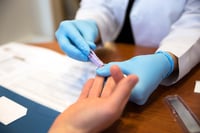Many Substance Use Treatment Facilities Fail to Offer HIV Testing, Study Finds

Only about 3 in 10 substance use treatment facilities in the United States offered HIV testing in 2018, and fewer than half of facilities treating people with medication for opioid use disorder (OUD) offered HIV testing, according to a study published in Psychiatric Services in Advance.
“Substance use treatment facilities are uniquely positioned to improve early identification, treatment, and prevention of HIV,” wrote Nicholas Riano, M.A.S., of the Weill Institute for Neurosciences; Mark Olfson, M.D., M.P.H., of the New York State Psychiatric Institute; and colleagues. “These facilities could play an important role in diagnosing HIV among the 25% of people with serious mental illness who have comorbid substance use disorders.”
Riano and colleagues examined data from the 2018 National Survey of Substance Abuse Treatment Services, an annual survey of drug and alcohol treatment facilities conducted by the Substance Abuse and Mental Health Services Administration. In addition to determining the types of substance use treatment offered (such as medication for OUD) and other mental health services, the surveys requested information about the availability of HIV testing and/or counseling at each facility.
Among 14,691 treatment facilities, 41% offered medication treatment for OUD and 68% offered other mental health services. Other findings among the facilities include the following:
- 29% offered HIV testing, 53% offered HIV counseling, 23% offered both, and 41% offered neither.
- Rates of HIV testing availability were significantly higher in facilities offering medication for OUD compared with those not offering such treatment (48% vs. 16%).
- Rates of HIV testing availability were higher among facilities offering mental health services compared with those not offering such services (31% vs. 24%).
- There was significant state-to-state variation in the proportion of facilities offering HIV testing, ranging from 9% to nearly 63% of facilities.
The finding that only 29% of substance use treatment facilities offered HIV testing in 2018 was consistent with prior reports, the authors wrote. “This low rate of HIV testing is a missed opportunity for early HIV diagnosis, treatment, and prevention, particularly at a time when the nation is grappling with the impact of the opioid epidemic and investing in the ‘Ending the HIV Epidemic’ initiative, which features testing as a key strategy,” they continued.
They concluded: “State- and federal-level policymakers have opportunities to use evidence-based approaches to increase HIV testing in these facilities, monitor adoption rates, and use financial incentives and their regulatory and licensing authority to increase testing and improve HIV-related health outcomes.”
For related information, see the Psychiatric Services report “Three Decades and Counting: HIV Service Provision in Outpatient Mental Health Settings.”
(Image: iStock/Alex Levine)
APA to Hold Virtual Town Hall With NIH Leaders
APA is sponsoring a free webinar on Tuesday, June 22, at noon ET with the directors of NIMH, NIDA, and NIAAA—Joshua Gordon, M.D., Ph.D., George Koob, Ph.D., and Nora Volkow, M.D., respectively. As the COVID-19 pandemic slowly recedes in the U.S., what do they see next on the horizon for mental health/substance use research? Join these leaders as they answer questions raised during their sessions at APA’s 2021 Annual Meeting and bring your own questions for the open discussion.
Don't miss out! To learn about newly posted articles in Psychiatric News, please sign up here.






